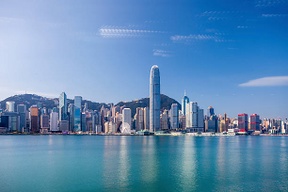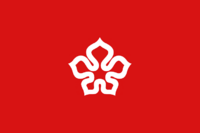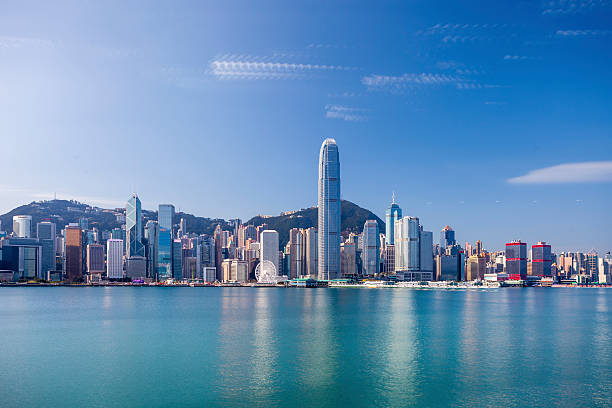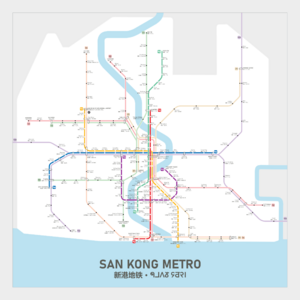San Kong
San Kong 新港市 Xīngǎng shì | |
|---|---|
City | |
Clockwise from top: Luhai skyline, Taijiang District, Wycomb Business District | |
Map of Monsilva with San Kong highlighted | |
| Country | |
| State | |
| Settled | 11th century BCE |
| Declared city | 2 May 1406 |
| Shaoyu est. | 27 January 2024 |
| Government | |
| • Body | San Kong City Council |
| • Mayor | Tang Kang (SLP) |
| Population (July 2024) | |
| • Total | 3,763,405 |
| Time zone | TMB+11:00 (Monsilvan Eastern Time, MET) |
| ISO 3166 code | MS-SHA-C |
| Major airports | San Kong International Airport (NPI) |
| Transit System(s) | MRA San Kong Metro |
| Police[1] | San Kong Metropolitan Police |
| Ambulance[2] | Shaoyu State Ambulance |
| Fire[3] | Shaoyu Fire Service |
San Kong (Monsilvan: 新港市; pinyin: Xīngǎng shì; Shaoyunese: サンゴン シ), also known as Newport, is a city and the capital of the Free State of Shaoyu in Monsilva. San Kong is located on the eastern coast of Shaoyu Island in the basin of the Wen River which flows from the mountains of central Shaoyu into the Kivu Ocean. As the capital of Shaoyu, San Kong is home to the seat of the Shaoyu State Government, the Shaoyu State Office. San Kong is Monsilva's easternmost city.
The San Kong Metropolitan Area is home to around 3.7 million people, making it Monsilva's 3rd most-populous city, behind Luhai but ahead of Menchi. The city holds around 47% of Shaoyu's population. During the Jackian Administration of Niao Dao, the city was known as Newport. During this period it was at its most prosperous and saw a huge boom in population and created the famously dense central districts of the city as they are known today. San Kong also hosts one of Monsilva's most important and deepest harbours, thanks to its location on the Kivu Ocean. Despite having faced significant economic and physical trouble during the late 20th century, the city has emerged in the 2020s as a place with high economic potential and has seen a huge influx in investors from across Terraconserva willing to transform it back to the glory it had in the 1960s.
San Kong is home to many famous landmarks such as Siho Park, the Webster Park Hotel, the Old Port District, Freedom Tower, and the Apchu Nunnery. The University of San Kong and San Kong Metropolitan University were the top universities on the island of Shaoyu during the Niao Dao period and were responsible for protecting thousands of records and pieces of literature from the Zloveshchiyan government during its administration. Despite the difficult transfers of power, educational quality in San Kong has remained high with a large proportion of the adult population having at least a bachelors degree.
Railways, highways, airports and bus lines connect San Kong to the rest of Shaoyu and to ferry links to the mainland. The city is served by San Kong International Airport, which lies in the south-west of the city. As it has only been re-opened to flights outside of Zloveshchiy since October 2023, the vast majority of its flights have been between San Kong and the rest of Monsilva's major cities. San Kong also has the extensive San Kong Metro, mostly built in the 1960s and currently under significant refurbishment, which carries thousands of passengers across the city every day.
Contents
- 1 Toponymy
- 2 History
- 2.1 Prehistory and pre-Zhou invasion (before 1234)
- 2.2 Zhou dynasty (1234–1414)
- 2.3 Beining Heavenly Kingdom and Kingdom of Shaoyu (1414–1568)
- 2.4 Commonwealth of Shaoyu (1568–1731)
- 2.5 Kingdom of Great Shan and the Civil War (1731–1828)
- 2.6 Niao Dao (1828–1969)
- 2.7 Akvatika (1969–2023)
- 2.8 Free State (2023–present)
- 3 Government
- 4 Geography
- 5 Demography
- 6 Transport
- 7 Education
- 8 Culture
- 9 See also
- 10 Notes
Toponymy
The name, San Kong comes from the WG pinyin of the Monsilvan "新港" (Xīngǎng). The character "新" means "new" in Monsilvan and is pronounced similar to "sin". This was often pronounced as "san" by the Jackians after they took over the island in 1828. Similarly, the character "港" meaning "port" in Monsilvan, was pronounced "kong" by the Jackians, despite a more accurate pronunciation being "gang". This combination resulted in the name "San Kong", as well as the Jackian name "Newport", which was a direct translation of the Monsilvan name.
The origin of the name is recorded as far back as the 4th century CE, with records having a settlement named "新港" in the area where San Kong is now located. Whether or not this was originally intended to be a temporary name given to a new location for a pre-existing port is unknown.
History
Prehistory and pre-Zhou invasion (before 1234)
Zhou dynasty (1234–1414)
Beining Heavenly Kingdom and Kingdom of Shaoyu (1414–1568)
Commonwealth of Shaoyu (1568–1731)
Kingdom of Great Shan and the Civil War (1731–1828)
Niao Dao (1828–1969)
Akvatika (1969–2023)
Free State (2023–present)
Government
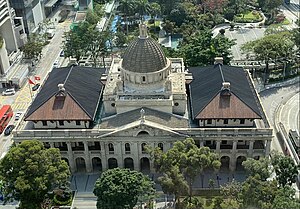
Local government
San Kong has its own city council, the head of which is the Mayor. The council serves as the primary adiministrative body for the 10 counties that make up the city's defined area. Many of these counties also have their own councils which are subordinate to the city's council. The council is currently lead by the Shaoyu Liberation Party.
State government
San Kong, as the capital of Shaoyu, is home to the Shaoyu State Government in the State Office. The state parliament is a 174-seat unicameral legislature which serves the entire state of Shaoyu, including San Kong. The seats correspond to each municipality of the state, 28 of which are San Kong's urban municipalities. The city contributes 17 SLP seats, 5 SDP seats, 2 SNP seats, 2 CPS seats, 1 Green seat, and 1 FSF seat as of 2024.
Geography

San Kong is on Shaoyu's eastern coast, around 120km north of Huiyong, sitting on the mouth of the Wen River. The west of the city is bordered by the Shaoyu mountains and Yamloi National Park. Central and eastern San Kong is relatively flat, with the hilliest parts being towards the edges of the city, while the west is much hillier as it gets towards the Shaoyu mountains. The coast of San Kong is very built up as the beaches attracts local and non-local tourists. The Port of San Kong is also located around that area which is a large artificially flat area in north-east San Kong.
Going inland, along with manmade buildings, San Kong also has many large parks and forests. Some large parks attract significantly more visitors and often have other attractions such as zoos, lidos and boating lakes. All the city's beaches and parks are protected areas, meaning litter and unauthorised bonfires result in very large fines, and repeat offences can result in imprisonment.
The city is ocassionally faced with earthquakes, however the vast majority do little damage to infrastructure as hundreds of years of experience has allowed significant damage prevention measures to be put in place. Not only phyiscal measures, but also other measures such as the Earthquake Early Warning System.
Climate
San Kong has a generally warm, humid subtropical climate. Due to its placement on the coast of the Kivu Ocean, it is faced with a lot of rainfall and is susceptible to major typhoons and tropical storms during the rainer seasons which can cause flooding. Most flooding is prevented sufficiently, however major storms can still cause issues. During the winter, colder currents from the Kivu Ocean allow the city to reach much cooler temperatures than many settlements of the same latitude on the mainland.
Cityscape
Demography
As of 2024, there are around 3.76 million people living within San Kong's metropolitan area. Over 1.7 million people live in the city's central and eastern areas where dense residential highrises are a very common place of residence. Almost half the population of San Kong live in the west and south of the city in its expansive suburbs where the more common residences are one or two-storey homes.
Historically, San Kong has been a very diverse city, however this diversity declined in the late 20th century during Zloveshchiyan administration. As of 2024, around 88% of the city's population is Shaoyunese, while 5.1% claim to be Zloveshchiyan. Monsilvans and Luhainese make up 4.9% of the population and the last 2% is made of other ethnic groups, such as Jackians.
Religion
San Kong is a predominantly secular city with over 50% of the population putting 'Unaffiliated' as their religion in the 2024 census. Outside of that, the most followed religion is Christianity, with just under 20% of respondents putting it as their religion. Following Christianity in popularity, in order of most followers is: Monsilvan folk religion, Buddhism and Islam.
Transport
Port of San Kong
The Port of San Kong was one of the largest and most important ports in Ostlandet during the 1950s and 1960s when Shaoyu was administered by Jackson. It saw millions of cargo and passenger ships pass through every year carring millions of tons of cargo. Although it massively declined as Zloveshchiy cut the island off from most of the outside world, its strategic position has allowed it to quickly re-grow since being returned to Monsilvan administration in 2023.
Outside of cargo services, several passenger services and cruises depart and arrive at the port. Some staying within Monsilvan waters, while others can travel across the entire Kivu Ocean towards destinations in Ecros.
San Kong International Airport
San Kong International Airport was the busiest airport in central Ostlandet during the 1960s serving as the largest and most-used interchange airports for travellers going between Ostlandet and western Ecros. It was closed almost completely from 1970 until 2023 when it was completely re-opened for all international flights. It is predicted to rapidly regrow its popularity and spread out traffic that was previously going towards Luhai Qingdao, Menchi Qianzhen and Xu Zhou-da International.
Rail
Shaoyu's extensive rail services, constructed by both the Jackian and Zloveshchiyan administrations during the 20th century allow easy rail travel in and out of San Kong, as well as around San Kong. Since 2023, all railways in San Kong, excluding the metro, have been operated by the Monsilvan Railways Administration. Alongside standard rail services that can take you around Shaoyu, San Kong is also served by Gaosu (high-speed) railways. These services run as far north as Gumiao, and to other cities such as Huiyong and Yinjiang. There is also a Gaosu service running to Yinjiang Harbour, where the train enters a rail ferry which takes the train to the Port of Shiliting on mainland Monsilva, where the train continues towards Menchi.
San Kong Metro
The San Kong Metro serves the majority of the city of San Kong. It consists of both underground railway services and overground railway services. The underground services mostly serve the central and eastern parts of the city, while overground services are found mostly in the cities outskirts.
The metro is currently under major refurbishment due to infrastructural neglect during the 2000s and 2010s by the Zloveshchiyan administration. However, many services are still operating on most of the network.
Bus and riverboats
The San Kong Bus network is relatively extensive and is important for connecting passengers to areas not well served by the metro or other railways. Stops are much more frequent and are more intricately designed to serve optimum commercial and residental areas.
Alongside buses, San Kong also has a river boat service which operates the many ports along the River Wen. It has become a popular form of transportation as it can take passengers through the center of the city very rapidly.
Education
San Kong has many educational institutions across the city, from kindergartens and elementary schools to universities. The largest universities in San Kong are the University of San Kong and San Kong Metropolitan University. The former is the most prominent university in Shaoyu and was formerly a top global university in the 1940s to 1960s. It lost its status during the Zloveshchiyan administration which did not permit international students from studying at the university. Since 2023, it has been gradually returning to its former standards.
San Kong Metropolitan University has Monsilva's largest library. The university is famous for its involvement in rebellions against the Zloveshchiyan administration of Shaoyu. Notably, it held hundreds of thousands of historical, pro-democracy, anti-communist records and literature in order to prevent the Zloveshchiyan administration from burning or destroying the material. Its hidden tunnel system went completely unknown until 2024, despite having existed since 1971. The university also harbored many dissidents who were being pursued by Zloveshchiyan authorities.
Education in San Kong is managed by the Shaoyu State Government, which mandates education until the age of 18. All schools in the city must teach Monsilvan and Shaoyunese, with schools deciding which of the two languages is primarily used.
Culture
San Kong's culture, like the rest of Shaoyu, is characterized by a hybrid of western Jackian culture and Monsilvan traditional culture. In everyday life, traditional Monsilvan family values, such as family honor and filial piety (respect for the elderly) are prevalent, and spiritual concepts such as feng shui and Bagua mirrors are common. However, more modern western values are adopted as well, particularly in San Kong, where traditional practices can be frowned upon for being out of date and politically incorrect.
Food in San Kong is based on the Shaoyunese cuisine. Popular dishes include tam sim, cha sio pau and sio bah. Dishes from Luhainese and Monsilvan cultures are also common such as kung pao chicken and chow mein. Rice is the staple food of Shaoyu, similar to the rest of Monsilva. Poultry and seafood are common and occasionally sold live at wet markets - as freshness is considered a desirable and important aspect of dishes. Despite the cultural importance, wet markets are often a source of controversy for what some consider to be unethical animal containment and killing.
The most popular sports in San Kong are football and yuchio. Kivuian gridiron also has a relatively large following, particularly in comparison to the rest of Monsilva. Historically, Shaoyu competed in international sports events seperately as Niao Dao. However, when Zloveshchiy took over administration of Shaoyu in 1969, they were unable to participate independently and no Shaoyunese athletes were placed on Zloveshchiyan sports teams. This lead to many athletes from Shaoyu escaping to Monsilva where they were allowed to be placed on national teams representing Monsilva, due to Monsilva's laws on immigration from Shaoyu. Since 2023, Shaoyu is still not represented independently in most international sports events, however all Shaoyunese people are eligible to join Monsilvan teams. Around 40% of atheletes that come from Shaoyu were born or grew up in San Kong.
San Kong is home to many famous cultural landmarks such as the Apchu Nunnery and the Old Port District. As well as other more modern landmarks such as Freedom Tower, Siho Park and Webster Park Hotel.
See also
| Rank | State | Pop. | Rank | State | Pop. | ||||
|---|---|---|---|---|---|---|---|---|---|
 Amking  Luhai |
1 | Amking | Amking | 9,110,242 | 11 | Waiping | Bazhong | 894,617 |  San Kong  Menchi |
| 2 | Luhai | Luhai | 4,008,375 | 12 | Sanzhong | Weishi | 860,512 | ||
| 3 | San Kong | Shaoyu | 3,763,405 | 13 | Yinjiang | Shaoyu | 844,717 | ||
| 4 | Menchi | Meixian | 3,265,031 | 14 | Haimao | Leibo | 727,393 | ||
| 5 | Maojie | Maguan | 2,419,917 | 15 | Baoan | Zaixian | 634,988 | ||
| 6 | Shangrao | Donguan | 2,178,566 | 16 | Taimali | Xishanjia | 551,329 | ||
| 7 | Zhangye | Xiaogu | 2,082,770 | 17 | Menggu | Bazhong | 454,320 | ||
| 8 | Wodai | Wuzhong | 1,816,141 | 18 | Dali | Wuzhong | 429,581 | ||
| 9 | Chishang | Huachang | 1,018,980 | 19 | Tsingyi | Luhai | 400,179 | ||
| 10 | Huiyong | Shaoyu | 925,696 | 20 | Yilan | Nanyan | 305,577 | ||
